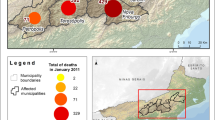Abstract
Purpose
To examine and suggest some solutions for health problems related to fear and anxiety at the moment of earthquake and to present how it affects working amount of emergency services despite having no destruction due to earthquake.
Methods
Patients admitted to emergency services due to symptoms related with earthquake but not destruction in Çanakkale earthquake on May 2014 were enrolled the study. Information about patients was gathered from hospital data system and patients’ files.
Results
Following the earthquake, 101 patients were admitted to Emergency Services with earthquake related symptoms that were not related to destruction. 68.3 % of patients injured while running, 19.8 % of patients were severely injured after jumping from a high place, 9.9 % of patients admitted to the emergency services with fear and anxiety and 1.9 % admitted with chest pain.
Conclusions
Even if there is no destruction in earthquake, people may behave improperly at the time of earthquake due to fear and anxiety causing serious traumatic and non-traumatic health problems. Earthquakes increase the workload of emergency departments even without destruction. The present study emphasizes the importance of behavior education of community during earthquake, early activation of hospital disaster programs and education of health care providers in natural disasters.
Zusammenfassung
Zielsetzung
Überprüfung und Vorschlag von Maßnahmen zur Vermeidung von gesundheitlichen Schäden im Zusammenhang mit Furcht und Angst während eines Erdbebens. Darlegung, wie sich ein Erdbeben auf die Arbeitslast in der Notaufnahme auswirkt, obwohl es nicht mit Zerstörungen einhergeht.
Methoden
In die Studie wurden Patienten eingeschlossen, die nach dem Erdbeben von Çanakkale im Mai 2014 wegen erdbebenbedingten, aber nicht wegen zerstörungsbedingten Symptomen in die Notaufnahme gebracht worden waren. Patientendaten wurden den Krankenhausinformationssystemen und den Patientenakten entnommen.
Ergebnisse
Nach dem Erdbeben wurden 101 Patienten mit erdbebenbedingten Symptomen, die aber nicht mit Zerstörungen zusammenhingen, in die Notaufnahmen gebracht. Ein Anteil von 68,3 % dieser Patienten hatte sich beim Laufen verletzt, 19,8 % hatten bei Sprüngen aus großer Höhe schwere Traumata davongezogen, 9,9 % wurden wegen Furcht und Angst in die Notaufnahme eingeliefert, 1,9 % aufgrund von Brustschmerzen.
Diskussion
Auch wenn es bei einem Erdbeben nicht zu Zerstörungen kommt, können sich Menschen aufgrund von Furcht und Angst irrational verhalten und in der Folge traumatische und nichttraumatische Gesundheitsschäden davontragen. Erdbeben erhöhen die Arbeitslast der Notaufnahmen auch ohne Zerstörungen. Diese Studie unterstreicht, wie wichtig erdbebenbezogene Verhaltensschulungen der Bevölkerung, eine frühe Aktivierung klinischer Notfallprogramme im Katastrophenfall und eine Unterweisung von Mitarbeitern des Gesundheitssystems im Umgang mit Naturkatastrophen sind.

Similar content being viewed by others
References
Guha-Sapir D, Vos F, Below R, Ponserre S (2011) Annual Disaster Statistical Review 2010 The numbers and trends. CRED, Brussels
Republic of Turkey Prime Ministry Disaster and Emergency Management Presidency website. http://www.deprem.gov.tr/sarbis/Shared/WebBelge.aspx?param=3210. Accessed June 2014
Lu-Ping Z, Rodriguez-Llanes JM, Qi W, van den Oever B, Westman L, Albela M et al (2012) Multiple injuries after earthquakes: a retrospective analysis on 1,871 injured patients from the 2008 Wenchuan earthquake. Crit Care 16:R87.
Li T, Jiang X, Chen H, Yang Z, Wang X, Wang M (2012) Orthopaedic injury analysis in the 2010 Yushu, China earthquake. Injury 43:886–890
Dong ZH, Yang ZG, Chen TW, Feng YC, Wang QL, Chu ZG (2009) Spinal injuries in the Sichuan earthquake. N Engl J Med 361:636–637.
Bartels SA, VanRooyen MJ (2012) Medical complications associated with earthquakes. Lancet. 379:748–757
Mulvey JM, Awan SU, Qadri AA, Maqsood MA (2008) Profile of injuries arising from the 2005 Kashmir earthquake: the first 72 h. Injury 39:554–560
Bulut M, Fedakar R, Akkose S, Akgoz S, Ozguc H, Tokyay R (2005) Medical experience of a university hospital in Turkey after the 1999 Marmara earthquake. Emerg Med J 22:494–498
Salimi J, Abbasi M, Khaji A, Zargar M (2009) Analysis of 274 patients with extremity injuries caused by the Bam earthquake. Chin J Traumatol 12:10–13
Peek-Asa C, Kraus JF, Bourque LB, Vimalachandra D, Yu J, Abrams J (1998) Fatal and hospitalized injuries resulting from the 1994 Northridge earthquake. Int J Epidemiol 27:459–465
Steptoe A (2009) The impact of natural disasters on myocardial infarction. Heart 95:1972–1973
Ogawa K, Tsuji I, Shiono K, Hisamichi S (2000) Increased acute myocardial infarction mortality following the 1995 Great Hanshin-Awaji earthquake in Japan. Int J Epidemiol 29:449–455
Suzuki S, Sakamoto S, Koide M, Fujita H, Sakuramoto H, Kuroda T et al (1997) Hanshin-Awaji earthquake as a trigger for acute myocardial infarction. Am Heart J 134:974–977
Karanci AN, Rustemli A (1995) Psychological consequences of the 1992 Erzincan (Turkey) earthquake. Disasters 19:8–18
Roberts YH, Mitchell MJ, Witman M, Taffaro C (2010) Mental health symptoms in youth affected by hurricane Katrina. Prof Psychol-Res Pract 41:10–18
Wu ZB, Xu JP, He LL (2014) Psychological consequences and associated risk factors among adult survivors of the 2008 Wenchuan earthquake. BMC Psychiatry 14:126
Jia Z, Tian W, Liu W, Cao Y, Yan J, Shun Z (2010) Are the elderly more vulnerable to psychological impact of natural disaster? A population-based survey of adult survivors of the 2008 Sichuan earthquake. BMC Public Health 10:172
Author information
Authors and Affiliations
Corresponding author
Ethics declarations
Conflict of interest
The authors have no conflicts of interest to disclose.
Funding source
No external funding was secured for this study.
Financial disclosure
The authors have no financial relationships relevant to this article to disclose.
Additional information
Redaktion
M. Fischer, Göppingen
K.‐G. Kanz, München
W. Schreiber, Wien
F. Walcher, Magdeburg
Rights and permissions
About this article
Cite this article
Yıldırım, A., Akdur, O. & Özçelik, H. Injuries and emergency department visits without building destruction after Gökçeada earthquake in Çanakkale, Turkey. Notfall Rettungsmed 18, 377–380 (2015). https://doi.org/10.1007/s10049-015-0014-z
Published:
Issue Date:
DOI: https://doi.org/10.1007/s10049-015-0014-z




